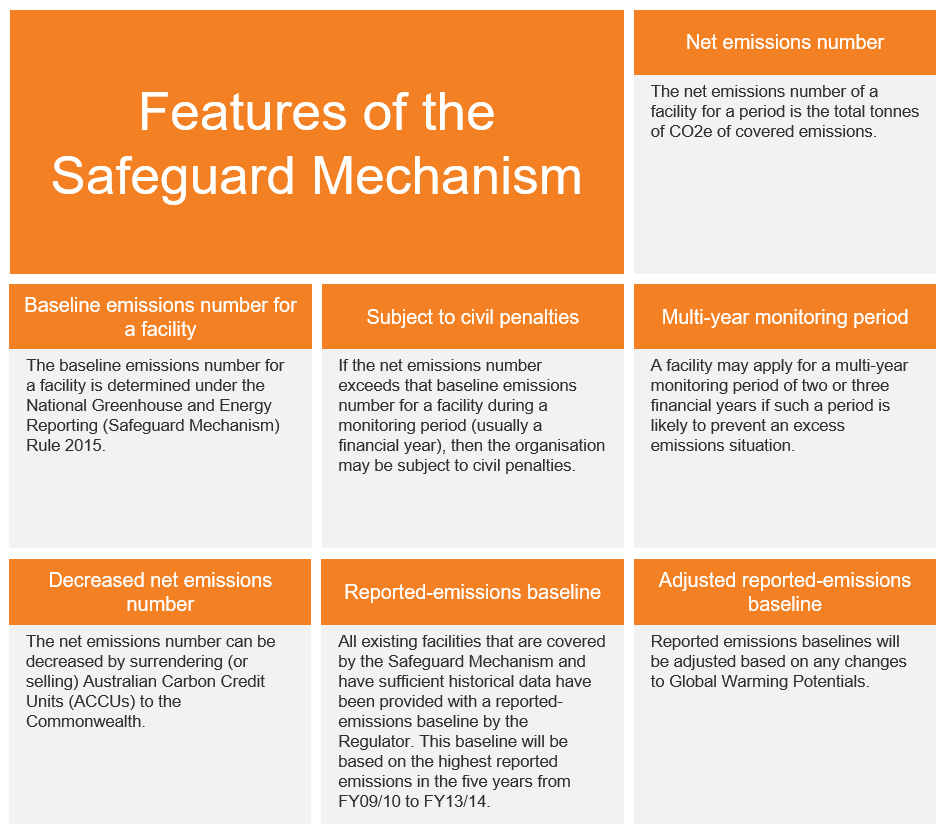The much discussed Safeguard Mechanism will take effect 1 July 2016. Covering an estimated 50% of Australia’s reported emissions, the Safeguard Mechanism is intended to prevent large facilities from increasing their emissions above their baseline. It covers those facilities that emit more than 100,000tCO2-e of Scope 1 emissions per annum.
However, while large emitters are showing little interest in the start of the safeguard mechanism, speculation surrounds the ways in which the Safeguard Mechanism could evolve in the future.
This article considers the features of the Safeguard Mechanism as it stands, the drivers that are likely to lead to changes in the future and the actions business can take now to prepare for a strengthening of the Safeguard Mechanism.
Drivers favouring the use of a market-based mechanism that offers policy flexibility
Australia has significant international climate change commitments. Our National Determined Commitment (NDC) is to deliver 26-28% reductions on 2005 emissions levels by 2030. We are also required to make deeper cuts to meet both our obligations under the new global climate agreement of limiting warming to within 2oC on pre-industrial levels and, as a member of the ‘High Ambition Coalition’, to work towards limiting warming to within 1.5oC. We see in the Safeguard Mechanism a flexible policy option for driving Australia’s largest emitters to deliver further reductions.
Also, as we are currently in the midst of an election campaign it is worth understanding the position of the ALP. If a Labor government was elected on 2 July, there may be even more significant changes to the regulations. Labor does not support the current policy and are in favour of an emissions trading scheme. That said, what we have also seen in the ALP’s positon is support for broadening the base of facilities captured under the Mechanism to include all facilities down to 25,000t CO2-e.

Issues to watch
A review of the Safeguard Mechanism is scheduled for June 2017. Minister Hunt advised the Ministerial Roundtable that a safeguarding issues paper will be released in the second half of 2016.
The flexibility of the Safeguard Mechanism is one of its most talked about features, as the ability to set emissions baselines is set out in the Rule rather that the Act. Therefore amendments to the Rule can be implemented without an act of parliament. The Minister for the Environment is therefore able to reduce baselines at any time in order to help meet Australia’s emissions reduction targets.
A further consideration arising from the negotiations concluded in Paris in 2015 is that national emissions targets are to be reviewed every five years. It is likely that this will result in Australia’s emissions targets being strengthened over time. The Government may therefore choose to introduce changes to the Safeguard Mechanism to drive emissions reductions and this will result in an increased liability for those entities captured under the scheme.
There is a shift in business’ risk profiles with the commencement of the Safeguard Mechanism. As Energetics’ Peter Holt said in his interview with Footprint, “Companies should ‘join the dots’ between the need for a national emissions trajectory declining towards net-zero emissions and the ramifications for their operations.”
One scenario is outlined in our recent abatement modelling work for the Department of the Environment. The report shows that the Emissions Reduction Fund and Safeguard Mechanism (working in conjunction to create a market for Australian Carbon Credit Units (ACCUs), have the potential to deliver more than 50% of the emissions reductions required if Australia is to reach its 2030 target of reducing emissions to 26-28% on 2005 levels. Noting that this is not the only option, as other policy levers can be used or new policies introduced such as an expansion of the RET.
Energetics’ recommendations:
- Understand your risk profile under the Safeguard Mechanism – establishing the link between national emissions trajectories and impact on your business.
- Establish a process for monitoring, refining and updating greenhouse gas forecasting on an ongoing basis.
- Review your greenhouse gas emissions forecast for each facility against your Safeguard Mechanism baseline to understand whether your business is likely to exceed its baseline. Businesses that exceed their baselines will be required to acquire and acquit ACCUs or other offsets.
- Assess whether there are other emission reduction opportunities at your facilities, which would help to reduce your business’ expected liability and exposure to future changes in the Safeguard Mechanism that could result in increased liability.
- Develop a carbon offset strategy to ensure your business can generate or acquire sufficient ACCUs to offset any residual liability.
- Maintain a watching brief on potential changes to the Safeguard Mechanism rules and regulations.
Energetics can help your business to efficiently and accurately navigate the more complex elements of complying with the Safeguard Mechanism. Please contact any one of our experts.






